We all know that businesses, whatever their size and industry, want more sales – that’s the whole reason for being in business after all. And one sure fire way to increase sales is to increase the traffic to your website – isn’t it?
Well, that’s true most of the time but not always… Your website might already be attracting plenty of visitors but a low conversion rate could be hampering your sales volumes. Fortunately, improving conversion rate is simpler and quicker than gaining an increase in web traffic.
For a significant number of businesses more visitors don’t lead to more sales
If your business website has plenty of visitors but sales haven’t grown have you ever questioned why?
Do you know why your digital marketing metrics are showing increased organic rankings, more clicks on your PPC Ads, and higher visitor numbers but your sales are static or unpredictable?
If not, you should… because if you have a low conversion rate you should be considering conversion rate optimisation. In many cases conversion rates can be increased with some quick, easy and inexpensive changes. Read on to find out how.
| Reasons for low conversion rate | |
| 1. | Poor Calls-to-Action |
| 2. | Poor User Experience |
| 3. | Targeting The Wrong Search Terms |
CONVERSION RATE OPTIMISATION:
THE SOLUTION TO LOW CONVERSION RATES
Fortunately improving conversion rates is fairly straightforward whether it requires better targeted keywords/search terms or whether it requires a better user experience on mobile devices, clearer landing pages and product pages, or an easier checkout page.
When it comes to improving the user experience it will almost certainly require some testing of alternative page layouts, different calls-to-action etc but targeting the right keywords and creating a better user experience will increase sales.
targeting the right keywords and creating a better user experience will increase sales
CRO BASICS– Know Your Data
Start with an analysis of your data on one or two pages that you expect to be converting visitors. Is the user behaviour what you would expect? Try and get a feel for your average conversion rate across the website. What is the Bounce Rate (or Engagement Rate) like, how long do website visitors spend on the page and which pages (if any) do they look at next? Is the website copy appealing and is the page mobile friendly?
Check your conversion rates in Google Analytics – making sure you have meaningful conversion events set up.
You can find all of these data in your Google Analytics account
Once you have a better understanding of these data that will help determine what improvements to the web page(s) are required.
CRO BASICS – User Engagement
Any web page with a low Engagement Rate (a Google Analytics 4 metric that is similar to the inverse of Bounce Rate) of 20% or less has something fundamentally wrong. It either doesn’t offer the information the visitor was expecting, it doesn’t clearly show the value proposition, it’s too slow or has a poor design leading to a poor user experience.
Similarly if the average time spent on the page is just a few seconds this also suggests the page is not doing its job. Most customers expect mobile friendliness, relevant content, shipping information and an easy checkout process (if relevant).
Use this checklist to see how your B2B or ecommerce site performs:
User Experience
Most of us are so familiar with our own websites that we often need a fresh pair of eyes to point out flaws. Why not ask someone independent (not from the business) to make a critical assessment of the troublesome pages (or even the whole site) as a first-time visitor.
If it’s an ecommerce website or online store, ask them to review the product descriptions and checkout process in particular. Problems in these 2 areas are a common cause of low ecommerce conversion rates.
If it is an ecommerce store, is it easy to find more information and advice? Are phone numbers and emails prominently displayed? Can they be viewed easily on mobile devices?
Is the shopping process and checkout page clear and simple? Is there a guest checkout option to encourage people to buy even if they do not want to register their payment details? Make sure buyers can see shipping costs and their checkout progress clearly.
Is all the information someone needs readily to hand on your product pages and have you used real high quality images rather than stock images? People don’t want to scroll to find product descriptions; they will quickly lose interest, which is a major factor for website conversion rate.
Also check the page is not overly complicated or essential information hard to find for potential customers. Use accordions or tabs to tuck away long descriptions so important information is easier to see, especially for mobile users. Show real customer reviews to provide social proof of the quality of your products or services.
Title and Description
The title and description displayed on the search listings should provide a good indication of what the visitor will find on the page. If not, modify them to more clearly state what the page is about. When a page is accurately described in the search listings, visitors don’t leave your site because they find what they expect. Provided, of course, that it is well-designed and offers a good user experience.
Don’t under-estimated the importance of these 2 relatively small pieces of text. After all click-through rate (CTR) is just as important as conversion rate. A site that attracts only very few visitors won’t be in a great position to optimise for conversions. So makes changes, test, monitor, rinse and repeat.

Page Speed
Again Google offer a free tool to check this (Page Speed Insights) so use it to check speed for both desktop and mobile searches separately. Both need to be fast and given the green light in Google’s traffic light system. If pages don’t have the green light the tool will make suggestions on how to speed up the page – these will almost always require the help of your web developer to implement.
An SEO Health Check or Technical SEO Audit will also check page speed among other on-page factors that may be limiting the success of a website. According to statistics more than 50% of users worldwide access the internet via a mobile device so no business can afford to ignore page speed.
h
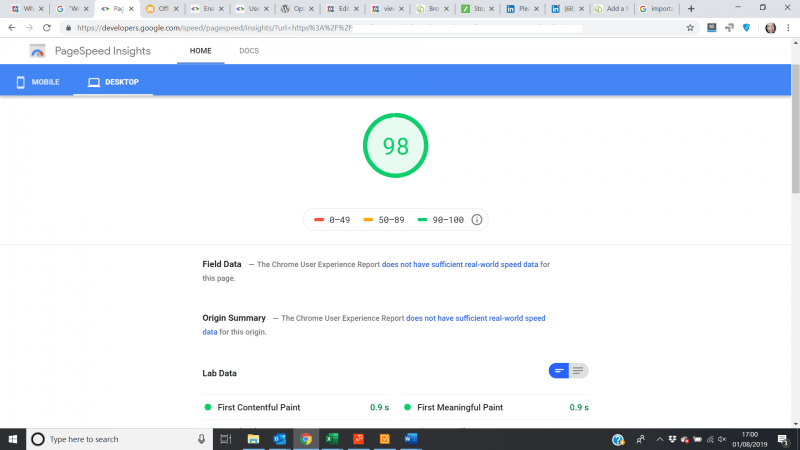
CRO BASICS – Calls-to-Action
A call-to-action (CTA) is simply a piece of content intended to encourage a website visitor to take a specific action like buy a product or service, register for more information or call up a company. The content can be an image overlaid with a small amount of text, a simple image, a simple button or even just some words within other text that are a clickable link.
Typically they include words to make it clear what action the website owner wants visitors to take, for instance:
- download our latest report
- call us today for more information
- buy now
- click here to find out more
Placement of CTAs
A CTA can be placed anywhere on a web page but is most effective near the top to ensure the maximum number of site visitors see it. Positioning it on the left also helps improve conversions as does having an image of a person on the right-hand-side looking at the call-to-action (who knew?).
Experimenting with tools
You can experiment with different wording, colours, imagery and location to determine which CTAs work best for your business with tools such as Crazy Egg which provide heatmaps, scrollmaps, and other visual reports to show exactly how people are responding to elements on your paid ads landing page or website as a whole.
Simple A/B testing, a split test or more complex digital experiments can reveal accurate data about the user behavior and visitors interactions with your site. This can help identify pages with low conversions. Or a simple test of ecommerce conversion rate is to offer free shipping as a trial. Alternatively, call us to find out how we can help with conversion rate optimisation (see what I did there).
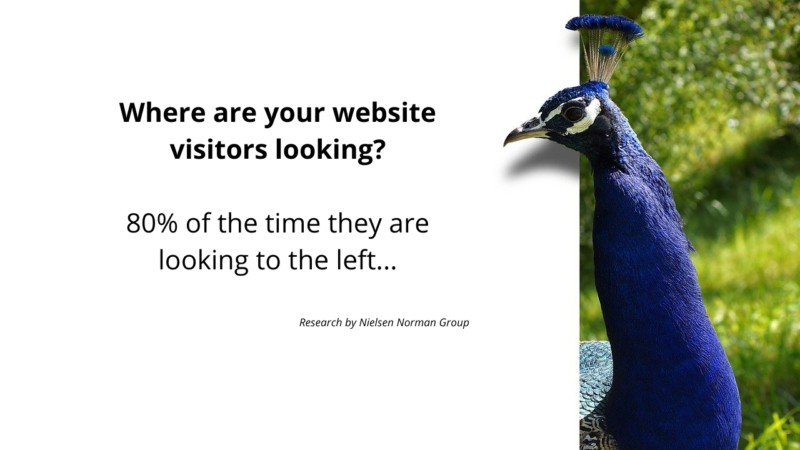
CRO BASICS – Test, Test, Test
There are 4 main elements on every web page that can influence a visitor’s experience so make sure you review, change and test all of them for maximum improvements in user engagement and conversions. They are:
- Call-To-Action
- Headings
- Images
- Text
Google provide free A/B testing functionality in Google Analytics 4 to help out with testing different versions of pages or different elements on the page to assist in the CRO process. Most websites where conversion rate is low can benefit from these simple A/B tests. They can be done at no cost so it’s a no brainer as an initial step to achieve a good conversion rate.

NO CORRELATION BETWEEN DIGITAL MARKETING METRICS AND SALES?
Now that we’ve looked at how conversion rate optimisation can increase sales let’s have a look at the 2 main reasons why website traffic and sales don’t correlate and how to fix low conversion rate issues:
1. Poor User Experience
The first main reason that visits are not converting to leads or sales is because of a poor user experience on the website as a whole or on individual key pages. Many businesses have websites that are not reaching their target audience via search engines. And if a web visitor cannot easily navigate an ecommerce site and find product pages then the ecommerce conversion rate will be low.
Check you site has a clear menu structure – and if using a “hamburger menu” ensure the 3 horizontal bars are easy to see. Consider a guest checkout option and maybe offer free shipping is that works for your products and business model. Simple changes can often have a big impact on average conversion rates
Reviewing the data
Look at these metrics below – a company has good visitor numbers that have been steadily growing over the past 2 years (in fact visitor numbers have grown 240% in that time). Sales on the other hand are unpredictable and follow no expected seasonal pattern, nor do they follow the trend of increasing visits.
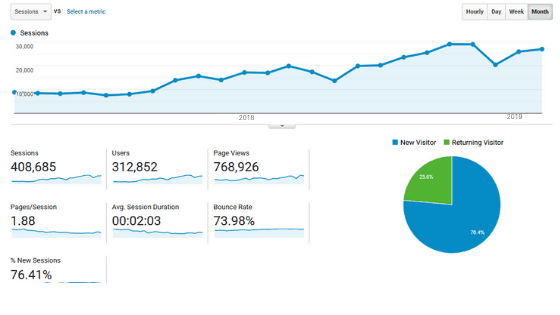
Now look at the further metrics below – the top 2 pages have good bounce rate and visitors stay on the site and read several pages (Note this is old Universal Analytics data from prior to 1st July 2023 when we switched to Google Analytics 4). Yet sales don’t correlate with this good user engagement even though the business is reaching it’s target audience.
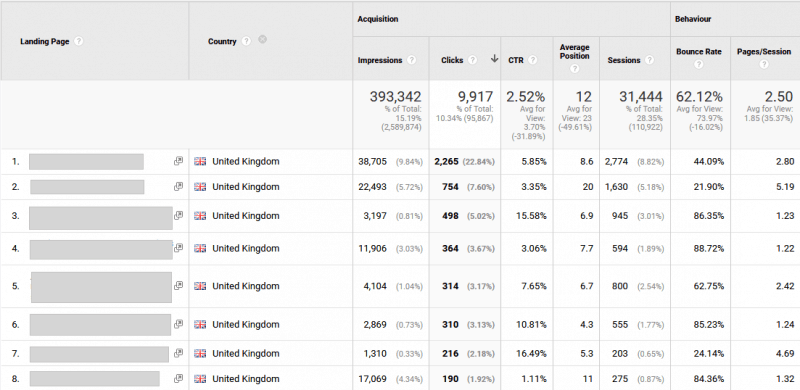
Investigating further
For this particular client, we investigated more closely the reason for this lack of correlation between visits and sales and it was clear that the well-engaged visitors, arriving at the website for the right search terms, had a good experience until they reached the page that should have had a clear call-to-action. On that page they were left hanging with no clear idea of how to make the next move and so left the website.
This particular business provides B2B services so their website is not an ecommerce store and conversion rates are less easy to predict. The site has an easy to use menu and search bar and one major conversion goal is to download a free ebook.
How did we fix the problem of poor user experience on a single key page?
We added clear calls-to-action so visitors could see immediately how to get in touch or download an ebook.. We added a large CTA containing the phone number (clickable from mobiles for a direct connection) and a short, simple form for arranging a callback at a convenient time.
We tested different locations, sizes and colours of these 2 CTAs on the page until we were confident of the most effective design and layout for better conversions.
This relatively quick and simple fix resulted in a 106% increase in phone calls.
This case study is a great example of how to increase conversions.
2. Targeting The Wrong Search Terms
Another major reason that increasing visits might not be producing conversions in the expected volumes can be the result of targeting the wrong search terms. In a example such as this the goal needs to be better traffic to the website in the first place.
We all know that good content plays an important part in building your brand, gaining a good online reputation and ultimately increasing sales. And part of a good content marketing strategy (as any content marketer will tell you) is to educate, inform and entertain – and not to be overly promotional about products and services every time a blog post, article, video or podcast is published.
Lack of proper audience targeting
But… if a content marketing strategy is not properly targeted the result can sometimes be a website and social media network that is a popular source of information with plenty of readers and good interaction – but that in itself won’t sell products or services. It can simply result in a low conversion rate. This is an example of how a great idea can lack focus on conversions.
In this situation a closer look at digital marketing metrics such as engagement rate/bounce rate will usually reveal that the majority of visitors are bypassing the selling pages with their enticing calls-to-action and heading straight for their regular fix of information and entertainment then leaving the site.
Some sites can even have blog posts that far outstrip the main business pages in terms of visitor numbers – but those pages can have a poor conversion rate, as mentioned earlier.
High visitor numbers vs low intent
Look at the 3rd and 4th row of the table below to see the difference in bounce rate on popular blog posts compared with the 1st and second row where bounce rate is low and visitors have a high buying intent.

The business, in cases like these, may simply be targeting the wrong keywords and need to review their keyword research and focus more on the search terms that are likely to bring customers – not information seekers.


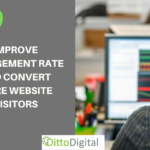


A really good overview of the common problem of poorly converting websites.
Instead of chasing higher rankings and more web traffic do a bit of CRO first. Can produce really good results
Absolutely true Pete,
Focus on conversions and existing traffic levels could produce a lot more online sales.
We’ve tried using a WP plugin to help work out what visitors to our website are doing so that we can improve their experience and then increase conversions.
It hasn’t helped much because there is no clear picture of user behaviour in our most important pages.
What should we be doing next?
Hi Jack, I’m assuming you have been using Hotjar or something similar. These sorts of plugins can be very useful tools but work best on websites with high volumes of traffic as it then starts to become clear what visitors are or aren’t doing (that they should be) on your money pages. For websites with low visitor numbers it can be difficult to observe any actionable patterns in user behaviour.
I would recommend simply reviewing the 3 main reasons for low conversion rates:
1. Poor Calls-to-Action – are your CTAs big and bold with a clear message?
2. Poor User Experience – are your pages fast to load and easy to use, have your checked your Core Web Vitals in Google Search Console?
3. Targeting The Wrong Search Terms – review your Keyword Research to be sure the visitors are looking for what you are selling
I’ve always used conversion rate optimisation as an integral part of digital marketing. Some businesses only start to think about CRO once they’re alreadt driving lots of traffic to the website but making this an integral part of the whole process would make it quicker and easier
Totally agree Tom – if CRO is an afterthought businesses could potentially have been missing out on customers for months or even years. It should be a consideration right from the design stage of a website, but, of course constantly review it as a website evolves and grows – much like SEO!
When a website is being developed I would think that there is limited opportunity to embed conversion rate optimisation – in part because there is no data available to support decisions but also because a lack of knowledge in dev teams. Most web developers barely consider SEO – or only at the most basic level – so to try and get them to consider CRO seems one step too far. Aren’t Web development, SE and CRO skills all separate areas of expertise?
You’re right Marco that web development, SEO and CRO are different areas of expertise but those teams can work collaboratively to produce a better end result i.e. a website that looks good, attracts traffic and convert to sales. Also, when a website is being redesigned there will be existing SEO value – that is essential to preserve – plus, possibly, some conversion data that can be used to build the new website better.
I can’t stress how important it is for SEO experts to be involved in website redesigns because I’ve seen first hand the negative impact of sites where the new design was all about look and feel and neglected existing SEO value in the old website. This can have a serious effect on organic rankings in Google searches and can take months or even years to recover from.
We are analysing our conversion rates at several points because “conversion rate” is not just at a single point of contact for visitors. We have the first point of contact is the search listings – so what percentage of people click on our listing. Then we have the landing page point of contact – what % of visitors click through to another page? Then what % take an action that we have classified as a goal. Our most important goal is “Get A Quote” (for the service we provide) but even then that has only achieved gaining contact details and sending a quote. We still need to measure how many of the visitors who complete that goal go on to actually become customers.
We have these stages to measure/analyse:
1. Click-Through Rate
2. User Engagement Rate (or the converse Bounce Rate)
3. Goal Conversion Rate
4. Sales Conversion Rate (visitor becomes an actual customer)
So when you discuss low conversion rate it could, I assume, be at any one of these stages or all of them.
You are absolutely right Ben that “conversion rate” can be at multiple levels. We have case studies that show high CTR and high rates of engagement (equivalent to your “get a quote”) but low levels of actual new customers. Conversely we have case studies that show very average rates of user engagement but of those figures a very high proportion become customers of our clients. So there are no hard and fast rules, but what this – and other data – shows is that there are multiple conversion levels as you point out and that every level should be optimised for conversions.
Our research also shows that Goals in Google Tag Manager are often set at too high a level by businesses and don’t directly relate to actual new customers. It’s always worth reviewing Goals in Google.
Good analysis of the widespread issue of websites with low conversions. All the step are necessary in digital marketing
Thanks Indu, too often low conversion rate is the last stage in assessing effectiveness of a website yet done sooner can lead to more conversions, leads or sales for relatively little effort and cost.